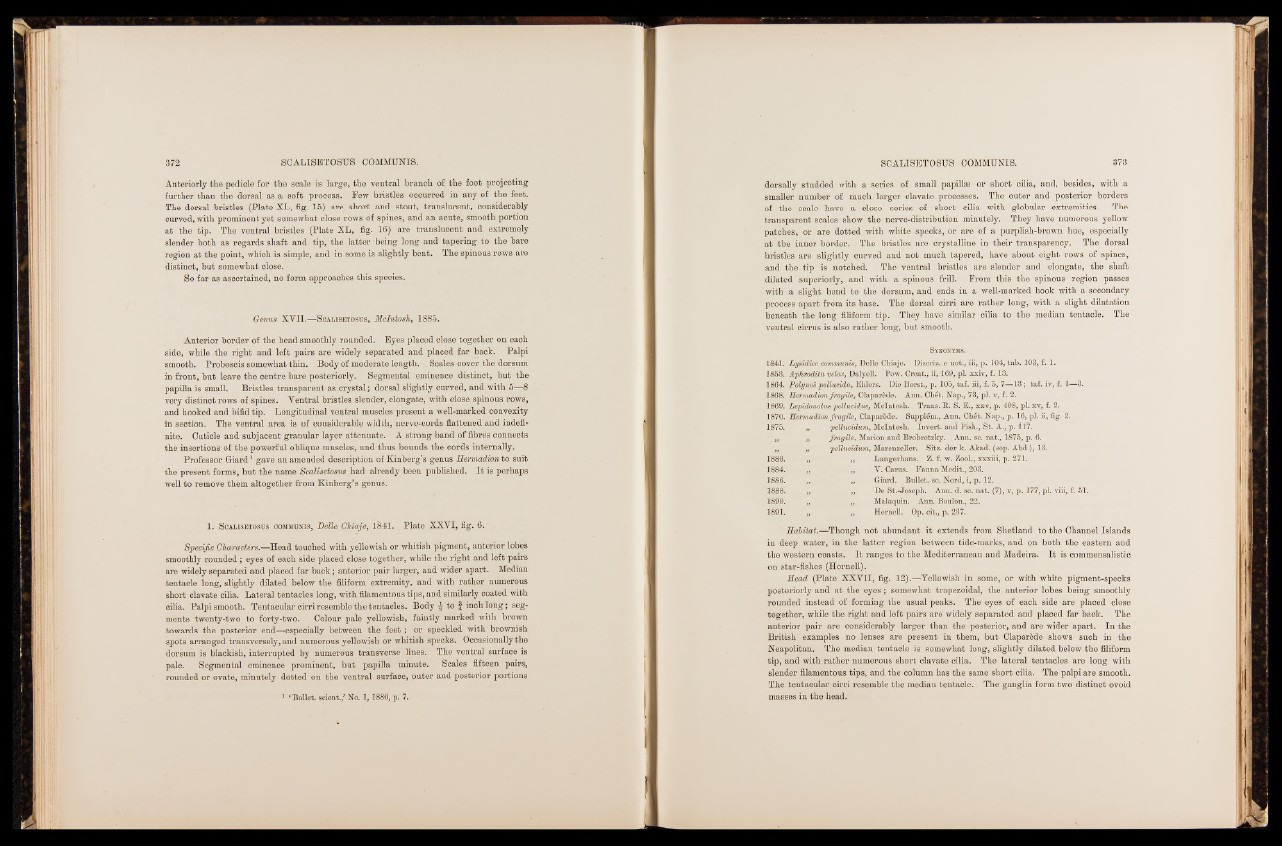
Anteriorly the pedicle for the scale is large, the ventral branch of the foot projecting
further than the dorsal as a soft process. Few bristles occurred in any of the feet.
The dorsal bristles (Plate XL, fig. 15) are short and stout, translucent, considerably
curved, with prominent yet somewhat close rows of spines, and an acute, smooth portion
at the tip. The ventral bristles (Plate XL, fig. 16) are translucent and extremely
slender both as regards shaft and tip, the latter being long and tapering to the bare
region at the point, which is simple, and in some is slightly bent. The spinous rows are
distinct, but somewhat close.
So far as ascertained, no form approaches this species.
Genus XVII.—S oalisetosus, McIntosh, 1885.
Anterior border of the head smoothly rounded. Eyes placed close together on each
side, while the right and left pairs are widely separated and placed far back. Palpi
smooth. Proboscis somewhat thin. Body of moderate length. Scales cover the dorsum
in front, but leave the centre bare posteriorly. Segmental eminence distinct, but the
papilla is small. Bristles transparent as crystal; dorsal slightly curved, and with 5—8
very distinct rows of spines. Ventral bristles slender, elongate, with close spinous rows,
and hooked and bifid tip. Longitudinal ventral muscles present a well-marked convexity
in section. The ventral area is of considerable width, nerve-cords flattened and indefinite.
Cuticle and subjacent granular layer attenuate. A strong band of fibres connects
the insertions of the powerful oblique muscles, and thus bounds the cords internally.
Professor G-iard1 gave an amended description of Kinberg’s genus Hermadion to suit
the present forms, but the name Scalisetosus had already been published. It is perhaps
well to remove them altogether from Kinberg’s genus.
1. S oalisetosus communis, Belle Ghiaje, 1841,, Plate XXVI, fig. 6.
Specific Characters.—Head touched with yellowish or whitish pigment, anterior lobes
smoothly rounded; eyes of each side placed close together, while the right and left pairs
are widely separated and placed far back; anterior pair larger, and wider apart. Median
tentacle long, slightly dilated below the filiform extremity, and with rather numerous
short clavate cilia. Lateral tentacles long, with filamentous tips, and similarly coated with
cilia. Palpi smooth. Tentacular cirri resemble the tentacles. Body % to f inch long; segments
twenty-two to forty-two. Colour pale yellowish, faintly marked with brown
towards the posterior end—especially between the fe e t; or speckled with brownish
spots arranged transversely, and numerous yellowish or whitish specks. Occasionally the
dorsum is blackish, interrupted by numerous transverse lines. The ventral surface is
pale. Segmental eminence prominent, but papilla minute. Scales fifteen pairs,
rounded or ovate, minutely dotted on the ventral surface, outer and posterior portions
‘ Bullet, scient./ No. 1, 1886, p. 7.
dorsally studded with a series of small papilla) or short cilia, and, besides, with a
smaller number of much larger clavate processes. The outer and posterior borders
of the scale have a close series of short cilia with globular extremities. The
transparent scales show the nerve-distribution minutely. They have numerous yellow
patches, or are dotted with white specks, or are of a purplish-brown hue, especially
at the inner border. The bristles are crystalline in their transparency. The dorsal
bristles are slightly curved and not much tapered, have about eight rows of spines,
and the tip is notched. The ventral bristles are slender and elongate, the shaft
dilated superiorly, and with a spinous frill. From this the spinous region passes
with a slight bend to the dorsum, and ends in a well-marked hook with a secondary
process apart from its base. The dorsal cirri are rather long, with a slight dilatation
beneath the long filiform tip. They have similar cilia to the median tentacle. The
ventral cirrus is also rather long, but smooth.
1841.
1853.
1864.
1868.
1869.
1870.
1875.
1880
1884
1886
1888
1890
1891
S ynonyms.
Lysidice communis, Delle Chiaje. Discriz. e not., iii, p. 104, tab. 103, f. 1.
Aphrodita velox, Dalyell. Pow. Créât., ii, 169, pi. xxiv, f. 13.
Polynoe pellucida, Ehlers. Die Borst., p. 105, taf. iii, f. 5, 7—13 ; taf. iv, f. 1—3.
Hermadion fragile, Claparède. Ann. Chet. Nap., 73, pi. v, f. 2.
Lepidonotu8 pellucidus, McIntosh. Trans. R. S. E., xxv, p. 408, pi. xv, f. 2.
Hermadion fragile, Claparède. Supplém., Ann. Chét. Nap., p. 16, pi. ii, fig. 2.
,, pellucidum, McIntosh. Invert, and Fish., St. A., p. 117.
,, fragile, Marion and Brobretzky. Ann, so. nat., 1875, p. 6.
„ pellucidum, Marenzeller. Sitz, der k. Akad. (sep. Abd.), 13.
,, ,, Langerhans. Z. f. w. Zool:, xxxiii, p. 271.
„ „ V. Cams. Fauna Médit., 203.
?, . „ Griard. Bullet, sc. Nord, i, p. 12.
,, „ De St.-Joseph. Ann. d. sc. nat. (7), v, p. 177, pl. viii, f. 51.
„ ,, Malaquin. Ann. Boulon., 22.
„ „ Hornell. Op. cit., p. 237.
Habitat.—Though not abundant it extends from Shetland to the Channel Islands
in deep water, in the latter region between tide-marks, and on both the eastern and
the western coasts. I t ranges to the Mediterranean and Madeira. I t is commensalistic
on star-fishes (Hornell).
Head (Plate XXVII, fig. 12).—Yellowish in some, or with white pigment-specks
posteriorly and at the eyes ; somewhat trapezoidal, the anterior lobes being smoothly
rounded instead of forming the usual peaks. The eyes of each side are placed close
together, while the right and left pairs are widely separated and placed far back. The
anterior pair are considerably larger than the posterior, and are wider apart. In the
British examples no lenses are present in them, but Claparède shows such in the
Neapolitan. The median tentacle is somewhat long, slightly dilated below the filiform
tip, and with rather numerous short clavate cilia. The lateral tentacles are long with
slender filamentous tips, and the column has the same short cilia. The palpi are smooth.
The tentacular cirri resemble the median tentacle. The ganglia form two distinct ovoid
masses in the head.